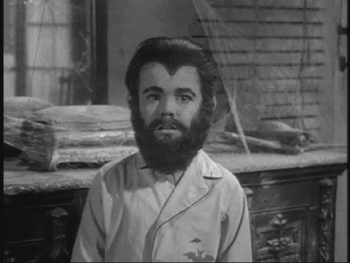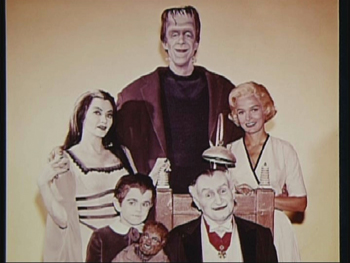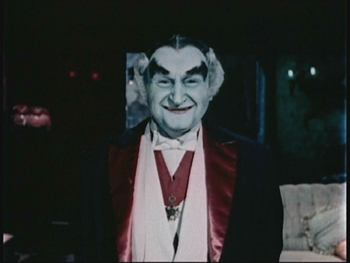 BUY IT AT AMAZON: CLICK HERE!
BUY IT AT AMAZON: CLICK HERE!
STUDIO: Universal
MSRP: $49.98
RATED: NR
RUNNING TIME: 13 hours, 45 minutes
SPECIAL FEATURES: Four documentaries on the show and the actors
Sometimes you just gotta wonder about the social context of these old sitcoms. Now, we demand more mystery, more development. Formula shows, such as The Outer Limits, have small followings, with more viewers tuning into Lost or Desperate Housewives, because they want to know what happens next. That implies change, direction for the characters, which is a given in drama; but even in our sitcoms, audiences today demand fresh systems of conflict.
Not so with the old audience of The Munsters, which falls into the category of sitcom occupied by Dick van Dyke and The Addams Family (and lampooned in Family Guy): no matter what happens during the show, it will all be forgotten by the next episode.
The Show
Prepare yourselves for a massive and facetious spoiler, for I am about to outline the plot of every single of the thirty-two episodes contained in this set. Before the first commercial break, Herman
Commercial break.

Surprisingly, not an overture for intercourse.
Herman gets himself tangled up in his own silly plot, though he remains blissfully unaware of his missteps until about ten seconds before the next break. Lily takes it upon herself to save him from himself, enlisting the aid of the other family members.
Commercial break the second.
Finally, Herman admits his error, by way of being caught while drugged, or rescued from Russians, et cetera. Herman reluctantly admits his defeat, his deficiency in thought and action, and returns, cowed, to Lily’s welcoming, corseted bosom.
If that repeated, formulaic storyline were the only thing The Munsters had to offer, it would have tanked. That’s my pre-gnostication, anyway. It certainly wouldn’t be much fun to revisit in current context, but the good news is that the show is consistently fun to watch, at least a good couple notches higher than "diverting". Its humor is primarily physical, since the dialogue is a bit too reliant on puns and unclever wordplay.
What it does well, though, is hard to beat. Fred Gwynne as Herman

The Beard would go on to have a successful film career of its own.
The remaining actors are decent, but don’t make much of an effort to bust out of their pigeon-holes. Herman may be a beaten-husband archetype, but Gwynne’s portrayal makes him memorable. The others are content to hide out in their boxes, fulfilling the bits of the formula that are required of them.
The crippling feature of the show — the bit that forces its place lower in the totem of American sit-coms — is its setting. The show is stuck in time. The particulars of its plots are lifted from the culture mores of the time, so the connection with a current audience relies on nostalgia, rather than common experience.
It’s a fun show, but its boundaries are a little too evident for it to be considered classic canon.
6.5 out of 10
The Look
You get a very nice-looking black-and-white fullscreen transfer. One of the good qualities of the show is that it’s not a "one room" sitcom, such as Cheers; The Munsters go outdoors fairly frequently, and so there is a nice variety of terrain, all of photographed with decent lighting and good balance. The transfer is mostly clean, but there is some scratching and signs of age that show their heads.
6.5 out of 10

"The election results are in, Mr. Kerry."
The Noise
All the sound is in Dolby digital 2.0 mono. It’s all mixed great, so the dialogue is always clear and the music is punchy. The theme song passes the "catchy as hell" test, and will remain in your head far longer than you want it to. As the season goes on, it gets to be pretty easy to spot the stock sound effects that the sound editors spliced in; a little more variety would have broadened the feel of the show a fair amount.
5 out of 10
The Goodies
The bonuses are few, but of a high quality. The third disc is devoted entirely to bonuses, and it features four documentaries.
The first is called "

When they say you’re having Betty Crocker for dinner…
The next three focus specifically on three of those actors: Fred Gwynne, Yvonne DeCarlo, and Al Lewis. These each are around 45 minutes long, and are loving and comprehensive compilations of information about the three actors. It’s a bit difficult for an outsider to crawl into the emotion, which tends toward the tragic, that these three features are laden with, but it’s not hard to respect.
8 out of 10
The Artwork
The slipcase (featuring Fred Gwynne’s grumpy face) was friction bonded to the top-folding disc holder, which made it a pain to get at the discs. It’s a clever and attention-grabbing set, though. The two discs of episodes are dual-sided, to cut down on the amount of bulk, so the box is manageable and charming, unless you’re one of those folks who thinks Fred Gwynne has a freakishly large mouth — I’m talking Kakihara-sized, here — and are afraid he’s going to eat you.
Heck, I’d just about fit inside his thigh.
7 out of 10

The case against colorization.
Overall 6.5 out of 10